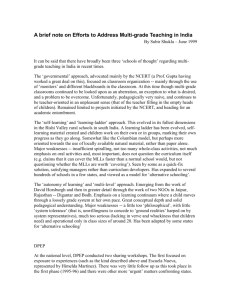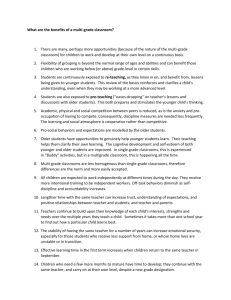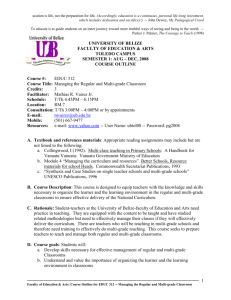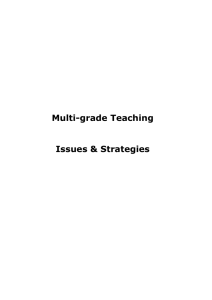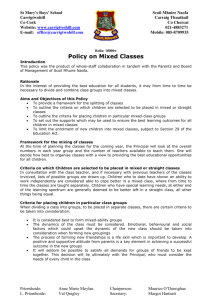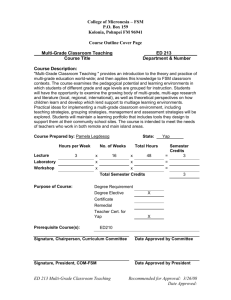Quality Basic Education for All: Challenges in Multi-Grade Teaching in... Taole Matshidiso Joyce Mediterranean Journal of Social Sciences
advertisement
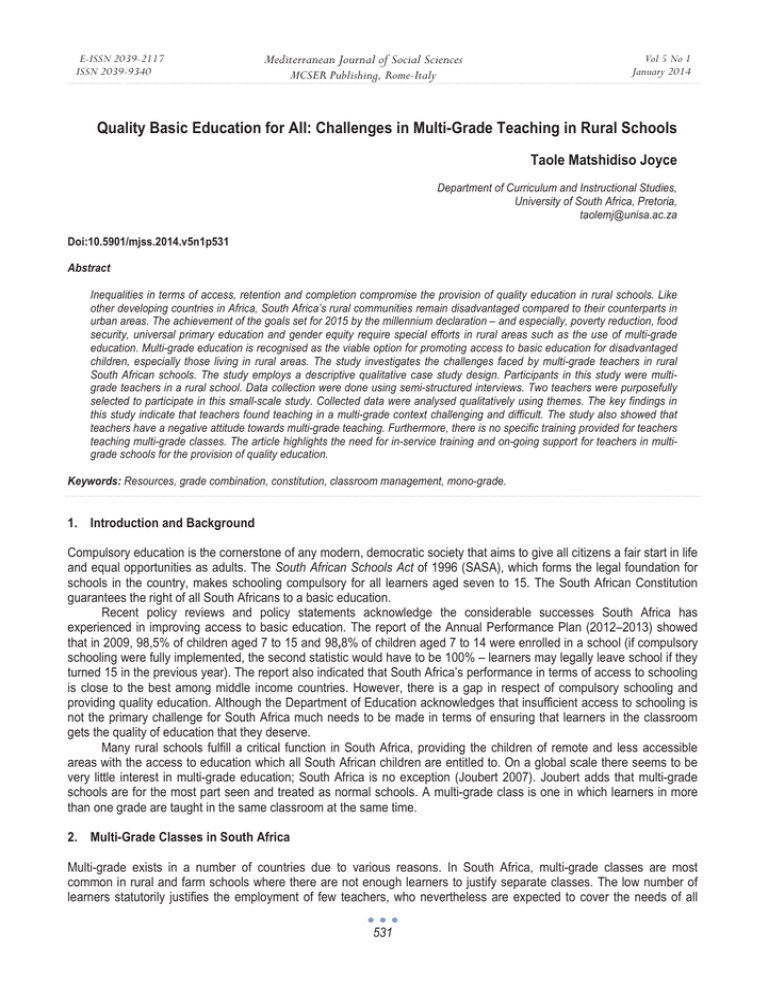
E-ISSN 2039-2117 ISSN 2039-9340 Mediterranean Journal of Social Sciences MCSER Publishing, Rome-Italy Vol 5 No 1 January 2014 Quality Basic Education for All: Challenges in Multi-Grade Teaching in Rural Schools Taole Matshidiso Joyce Department of Curriculum and Instructional Studies, University of South Africa, Pretoria, taolemj@unisa.ac.za Doi:10.5901/mjss.2014.v5n1p531 Abstract Inequalities in terms of access, retention and completion compromise the provision of quality education in rural schools. Like other developing countries in Africa, South Africa’s rural communities remain disadvantaged compared to their counterparts in urban areas. The achievement of the goals set for 2015 by the millennium declaration – and especially, poverty reduction, food security, universal primary education and gender equity require special efforts in rural areas such as the use of multi-grade education. Multi-grade education is recognised as the viable option for promoting access to basic education for disadvantaged children, especially those living in rural areas. The study investigates the challenges faced by multi-grade teachers in rural South African schools. The study employs a descriptive qualitative case study design. Participants in this study were multigrade teachers in a rural school. Data collection were done using semi-structured interviews. Two teachers were purposefully selected to participate in this small-scale study. Collected data were analysed qualitatively using themes. The key findings in this study indicate that teachers found teaching in a multi-grade context challenging and difficult. The study also showed that teachers have a negative attitude towards multi-grade teaching. Furthermore, there is no specific training provided for teachers teaching multi-grade classes. The article highlights the need for in-service training and on-going support for teachers in multigrade schools for the provision of quality education. Keywords: Resources, grade combination, constitution, classroom management, mono-grade. 1. Introduction and Background Compulsory education is the cornerstone of any modern, democratic society that aims to give all citizens a fair start in life and equal opportunities as adults. The South African Schools Act of 1996 (SASA), which forms the legal foundation for schools in the country, makes schooling compulsory for all learners aged seven to 15. The South African Constitution guarantees the right of all South Africans to a basic education. Recent policy reviews and policy statements acknowledge the considerable successes South Africa has experienced in improving access to basic education. The report of the Annual Performance Plan (2012–2013) showed that in 2009, 98,5% of children aged 7 to 15 and 98,8% of children aged 7 to 14 were enrolled in a school (if compulsory schooling were fully implemented, the second statistic would have to be 100% – learners may legally leave school if they turned 15 in the previous year). The report also indicated that South Africa’s performance in terms of access to schooling is close to the best among middle income countries. However, there is a gap in respect of compulsory schooling and providing quality education. Although the Department of Education acknowledges that insufficient access to schooling is not the primary challenge for South Africa much needs to be made in terms of ensuring that learners in the classroom gets the quality of education that they deserve. Many rural schools fulfill a critical function in South Africa, providing the children of remote and less accessible areas with the access to education which all South African children are entitled to. On a global scale there seems to be very little interest in multi-grade education; South Africa is no exception (Joubert 2007). Joubert adds that multi-grade schools are for the most part seen and treated as normal schools. A multi-grade class is one in which learners in more than one grade are taught in the same classroom at the same time. 2. Multi-Grade Classes in South Africa Multi-grade exists in a number of countries due to various reasons. In South Africa, multi-grade classes are most common in rural and farm schools where there are not enough learners to justify separate classes. The low number of learners statutorily justifies the employment of few teachers, who nevertheless are expected to cover the needs of all 531 E-ISSN 2039-2117 ISSN 2039-9340 Mediterranean Journal of Social Sciences MCSER Publishing, Rome-Italy Vol 5 No 1 January 2014 learners. In some instances multi-grade is used where there is a shortage of teachers and classrooms. As a result learners belonging to different grades, with different levels of learning experiences and with different types of skills are taught by a single teacher. These schools, known nationally and internationally as multi-grade schools fulfill a function of national importance, as they provide the children of remote and less accessible areas with the access to education. Teachers in multi-grade schools are confronted with significant challenges as they have to teach two or more age groups simultaneously and possibly more than one curriculum subject in the same class. According to the DBE Report on the 2008 and 2009 Annual Surveys for Ordinary Schools published in 2011, the number of schools with multi-grade classes was 6 432 (approximately 25%) in 2008 and 6 619 (approximately 26%) by 2009. In 2009, the majority of schools in the country that had multi-grade classes were, by far, primary schools. Of the approximately 6 600 ordinary schools with multi-grade classes in South Africa, close to 5 000 were primary schools, while only 184 secondary schools reported having multi-grade classes. The following table gives the summary of multigrade schools in South Africa. Source: Report on the 2008 and 2009 yearly surveys for ordinary schools (DBE 2012:9) Table 1 shows the number and percentage of schools with multi-grade classes by province, in 2008 and 2009. Nationally the number of schools with multi-grade classes increased from 6 432 (approximately 25%) in 2008 to 6 619 (approximately 26%) in 2009 Department of Basic Education (2012). However, three provinces (the Free State, Gauteng, the Northern Cape) show a decrease in the number of schools with multi-grade classes over this two-year period. The Western Cape however shows a significant increase in the number of multi-grade classes over the two years, from 312 in 2008 schools to 386 schools in 2009. The report of the task team for the review of the implementation of the National Curriculum Statement (NCS) DBE (2009:60) acknowledged that no specific training has been provided for teachers teaching multi-grade classes and there is lack of policy guidance for these teachers. The task team recommended that research and support is needed for teachers teaching in the multi-grade context. However, nothing has been done to assist teachers in multi-grade context. 3. Research Methodology The study is used in the interpretative paradigm. Interpretive research is not just the effortless collection of data but the working of data so as to reveal the essence of the participants’ experiences and reasons for doing things the way they do (Henning, Van Rensburg & Smit 2004). To this end, a rich, thick description was written interpreting the lives and experiences of the participants. As the objective of this inquiry was to describe and explain how teachers make meaning of their multi-grade teaching context, a qualitative approach was chosen. A qualitative approach attempts to understand human phenomena and investigates the meaning that people give to the events they experience (Henning et al. 2004). Furthermore, the research design followed in my research was the case study - “a form of qualitative research focused on providing a detailed account of one or more cases” (Johnson & Christensen 2004). 3.1 Sampling The researcher purposefully chooses participants that will best help her to understand the phenomena under study and 532 E-ISSN 2039-2117 ISSN 2039-9340 Mediterranean Journal of Social Sciences MCSER Publishing, Rome-Italy Vol 5 No 1 January 2014 the research questions. Therefore, teachers who are currently teaching in multi-grade classes were chosen to participate in the study. Because there are few teachers in multi-grade schools, only two teachers were used in the study. As Patton (1990) indicated, the logic and power of purposive sampling lies in selection of “information-rich” cases for study in depth. Information-rich cases are those from which one can learn a great deal about issues of central importance to the purpose of the research. All participants met the requirement of qualified teachers in line with the South African National Framework for Teacher Education and Training; none of them were trained in multi-grade teaching. Two schools were selected to participate in the study. The selection of the schools was purposeful as only schools which practices multi-grade teaching were selected to participate in the study. Most schools are situated in poverty stricken villages where there are no roads, sanitation and resources such as clinics and churches. Many learners come from poor families where the main source of income is the government grants for example, child and old-age grant. One school has four classrooms, three teachers and has grade R to grade 6 classes. The other school has five classrooms with four teachers including the principal, catering grade R to grade 6. 3.2 Data collection techniques Semi-structured interviews were used as the primary data collection tool. This method is seen by the researcher as the appropriate method for data collection as it will give the participants an opportunity to respond to questions and ask questions to obtain clarity if they do not understand. Since questions are presented in the same way to all the participants, this will minimise the role and influence of the researcher and enable a more objective comparison of the results. To boost the credibility of the results classroom observation and a researchers’ journal was used. A researcher’s journal was used to record impressions during the interviews and details of the interactions between the researcher and the interviewees. Other documents such as teacher files and lesson plans were perused. Teachers were observed in their classrooms. Classroom observation focused mainly on teaching methods and classroom management strategies. 3.3 Data analysis The interviews were first transcribed in detail and saved. In order to achieve a deep understanding of the lived experiences from the participants’ viewpoint the data was systematically examined. Transcripts from the interviews, observation sessions and the journal were analysed and the codes and the categories were determined and then formulated into themes.. 3.4 Ethical consideration Ethical aspects were considered during this research. Participants signed a consent form to participate in interviews and also to record interviews. Participation was voluntary, which suggests that participants have a choice to withdraw from the study for any reason and at any time. Participants were assured that their responses will be treated confidentially. 4. Findings The data collected were consolidated and categorised into themes. Three themes were identified namely: classroom management, training and large classes. 4.1 Classroom management It is the responsibility of the teacher to create a classroom that is conducive to teaching and learning and free from disruptive behaviour. However, teachers in multi-grade classrooms indicated that classroom management was particularly problematic for them. They indicated that they do not know how to maintain discipline in their classes as in most cases learners are noisy. This is illustrated by the following extracts from the narratives: The learners are noisy in the classroom and I spend most of my time dealing with discipline than actual teaching. It’s not easy to deal with learners of different grades. I spent the whole day running up and down in an attempt to discipline the learners. They do not want to sit still in the classroom. When I work with one grade the other grade will be making noise. 533 E-ISSN 2039-2117 ISSN 2039-9340 Mediterranean Journal of Social Sciences MCSER Publishing, Rome-Italy Vol 5 No 1 January 2014 Teachers in multi-grade classrooms use group-work method frequently. Teachers indicated that they are faced with problems because learners are disruptive, as a result teachers spent more time on disciplining learners than in actual teaching. This is an indication of the fact that teachers do not have the necessary skills and expertise needed to function effectively in multi-grade classrooms. 4.2 Training Teachers indicated that they are not giving raining for multi-grate teaching even in their initial teacher training. This creates a problem if they are to teach multi grade classes they said: I don’t know what to do in this class; I sometimes neglect the other class and focus on only one class. I know it’s wrong but what can I do? I was never trained for this. I am under a lot of pressure and I am struggling. It is painful because learners under my care do not get education. If I was trained how to handling multi-grade classes I could have been better. I am just thrown in this situation with no support from anyone. The above quotes suggest that training is not done for teachers in multi-grade classes. Teachers are more or less left to explore and learn multi-grade teaching pedagogies on their own, through the solitary experiences in their remote rural schools. 4.3 Large classes Teachers reported being overwhelmed by the high number of learners in their classes. As a result they could not organise their classrooms accordingly especially the Grade R and grade one classrooms. Here are some of their comments: I have more than sixty learners in my classroom. I am teaching Grade R and Grade one. My classroom is full, I cannot even move around when learners are doing group work. We have enough classrooms I don’t know why they are not separating these classes, it’s difficult for me. In addition, teachers indicated that they cannot provide individual attention to their learners especially those who need experiences barriers to learning. One teacher said: “I can’t give individual attention to learners; especially those who are struggling because I have other subjects that I need to prepare for and teach”. 5. Discussion Jacobs, Vakalisa & Gawe (2011) argue that no matter where teaching occurs it is the responsibility of the teacher to create an environment that is conducive to teaching and learning. This can only be achieved if teachers have a repertoire of classroom management skills. Teachers reported to have problems in managing their classrooms. Research indicated that teaching in multi-grade classes is demanding and more complex than teaching a mono-grade class (Little 2004; Little 2005; Mulkeen and Higgins 2009; Mulryane-Kyne 2009). This is attributed to the different levels, age and capabilities of learners in one classroom. Mulkeen and Higgins (2009) points out that teaching in multi-grade classrooms requires greater effort in planning, adapting instruction and managing the classes. Large classes are seen as the other problem for teachers in multi-grade classrooms. This is supported by the Department of Basic Education (DBE 2012) that class size will affect the success of the multi-grade program. DBE (2012) adds that multi-grade can only work with a balanced class of twenty-five, be more successful with a class of eighteen or twenty and become increasingly difficult with a class of more than twenty-five. Teachers are able to provide effective teaching and learning and to engage all learners if the class size is small. The important duty of a teacher is to make every learner involved in learning activities but this becomes difficult if not impossible in over-crowded classrooms. Smaller class sizes in a multi-grade setting give an opportunity for each individual learner to receive more teacher attention. Mulryane-Kyne (2009:23) emphasises the fact that when teachers work with fewer learners they will be able to correct learners tasks, provide timely feedback, be able to cover the curriculum and give individual attention to learners, more than in a large multi-grade class. The results of the study show that there are weaknesses in the education system in the provision of training and professional support to teachers in multi-grade schools. Little has been done by the Department of Basic Education to 534 E-ISSN 2039-2117 ISSN 2039-9340 Mediterranean Journal of Social Sciences MCSER Publishing, Rome-Italy Vol 5 No 1 January 2014 ensure that teachers in a multi-grade classroom have the necessary expertise to deal with the situation that they are facing. Studies on multi-grade teaching generally report the lack of preparedness of teachers for multi-grade settings (Mulryane-Kyne, 2005; Lingam, 2007; Little, 2005). The curriculum consists of learning competencies that are specifically designed for regular school situations and the multi-grade teachers find it difficult to make the content meaningful to pupils. The average teacher working in a small rural school needs to acquire new knowledge and skills and continually improve their expertise in teaching in the demanding context of the multi-grade classroom. They need to develop personal competencies falling beyond the established initial and in-service teacher training curricula, which are oriented towards conventional mono-grade teaching (Koulouris & Sotiriou, 2006). According to Joubert (2010) teacher training should provide multi-grade teachers with focused support to interpret the curriculum and to plan for and manage learning for their special circumstances. For teachers to play the critical role expected of them and to meet the challenging pedagogical practices in their classroom, targeted training needs to be provided. 6. Conclusion Training remains the only viable option for teachers in multi-grade schools for effective teaching and learning to take place. Teachers need to be developed through in-service training workshops to ensure that they know how to handle multi-grade classes. For example, teachers need to know that when they handle one grade in the class, they should give group activities or individual activities to the other class learners. These activities need to be monitored with the help of the gifted learners in the classroom. This could also promote independent learning. This should be done to ensure that discipline is maintained in the class because when learners are idling they tend to be out of control. It should be pointed out that the responsibility of the teacher increases in setting up the apt classroom situation and he/she can do that if he/she has received proper training. Teachers need to be provided with opportunities for continuous professional development through a number of different training initiatives such as collaboration and sharing of knowledge in informal communication processes, which foster the improvement of personal competences in multi-grade teachers. References Brown, B.A. (2010). Teachers’ accounts of the usefulness of multi-grade teaching in promoting sustainable human development related outcomes in rural South Africa. Journal of Southern African Studies, 36(1):189-207. DBE (Department of Basic Education). (2012). Report on the 2008 and 2009 Annual Surveys for ordinary schools. Pretoria: Government Printers. DBE (Department of Basic Education), (2009). Review of the Task Team for the Review of the Implementation of the National Curriculum Statement. Final Report. Pretoria: Government Printers. Henning E, Van Rensburg W, Smit B. (2004). Finding your way in qualitative research. Pretoria: Van Schaik. Jacobs, M, Vakalisa, NCG & Gawe, N. 2011. Teaching-Learning Dynamics. South Africa: Pearson Education South Africa. Johnson B, Christensen L. (2004). Educational research: quantitative, qualitative and mixed Approaches. (2nd edition.). Boston: Pearson. Joubert, J. (2007). Adapted/Adjusted curriculum for multi-graded teaching in Africa: a real solution? [Online] Available: http://multigrade.ioe.ac.uk. (April 14, 2009). Joubert, J. (2010). Multi-grade teaching in South Africa. Commonwealth Education Partnerships. [Online] Available: http://www.cedol.org /ip-content/upload/2012/02/58-56-2010.pdf (May 14,2011) Juvane, V. (2005). Redefining the role of multi-grade teaching. Working document prepared for the Ministerial Seminar on Education for Rural People in Africa: Policy Lessons, Options and Priorities. Addis Ababa, Ethiopia, 7–9 September 2005. Juvane, V. (2007). Multigrade teaching can improve quality of primary education. Commonwealth Education. [Online]Available:http//www.thecommonwealth.org/news/160291/090307teaching.htm. (March 7, 2011) Juvane, V. (2010). Southern African multigrade education. Paper presented for the South African multigrade education conference Cape Peninsula University of Technology, Wellington Campus. Koulouris P, Sotiriou S. (2006). Building lifelong learning networks of teachers for the development of competence in teaching in small rural schools. EC-TEL, Workshop proceedings, 131-147. Lingam, G. (2007). Pedagogical practices: the case of multi-class teaching in Fiji primary school. Educational Research and Review, 2(7):186-192. Little, AW. (1995). Multi-grade teaching - A review of research and practice. Education Research, pp. 63. Serial No. 12. Overseas development Administration, London, [online] Available:http://multigrade.ioe.ac.uk/fulltext/fulltextLittlereview.pdf (May 22, 2010), Little, AW. (2005). Learning and teaching in multigrade settings. Paper prepared for the UNESCO 2005 EFA Monitoring Report. [Online].Available: http:// www.skoleplassen.hisf.no/Rapportar/LearningandTeachinginMultigrade (September 16, 2007). Mulryan-Kyne, C. (2005). Teaching and Learning in multi-grade classrooms: More questions than answers. Oideas, 51:85-95 535 E-ISSN 2039-2117 ISSN 2039-9340 Mediterranean Journal of Social Sciences MCSER Publishing, Rome-Italy Vol 5 No 1 January 2014 Mulkeen A G, Higgins C. (2009). Multi grade teaching in Sub-Sahara Africa: Lessons from Uganda, Senegal and The Gambi. USA: World Bank Publication. Patton, MQ. (1990). Qualitative evaluation and research methods. Newbury: Cambridge University Press Republic of South Africa. (1996). The South African Schools Act, 84 of 1996. Pretoria: Government Printer. Republic of South Africa. (1996). Constitution of the Republic of South Africa Act, 108 of 1996. Pretoria: Government Printer. 536
